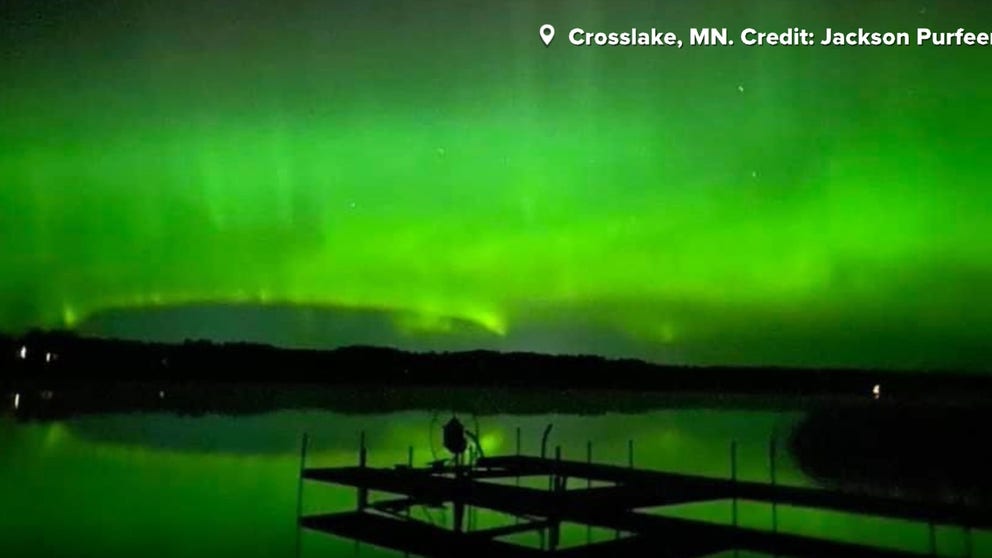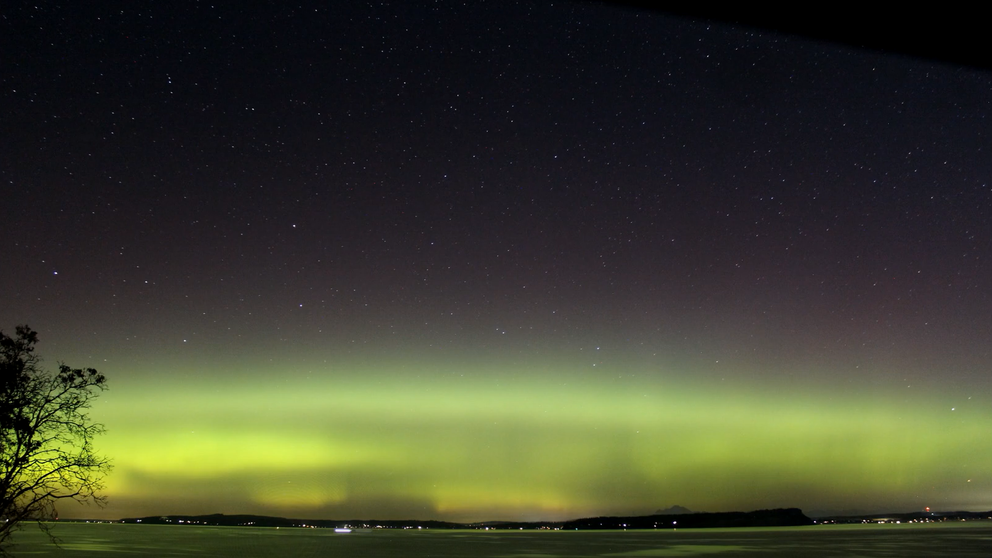Aurora lights greatest hits: Solar flare puts on colorful show across northern US
Northern lights were extra active and bright thanks to a solar flare
Solar flare puts on colorful show across northern US
Northern lights were extra active and bright thanks to a solar flare.
Electrically charged particles bouncing into Earth's atmosphere created a dazzling show of aurora lights across the northern U.S. Monday night.
The northern lights, or aurora lights, usually are only visible to our neighbors to the north in Canada and Alaska, but the impact from a solar flare increased the range of the lights down to the lower 48, and the views did not disappoint.
Social media users from Washington, Minnesota, Montana and the northeast shared their views of the neon lights in the sky.
The Space Weather Prediction Center with NOAA issued a geomagnetic storm watch for Monday and Tuesday. Space weather events happen when the sun emits a coronal mass ejection or solar flare, hitting Earth's atmosphere. The result is the green and purple colors in the sky around the planet's poles.
RELATED: 7 facts about Northern Lights
Aurora lights are most vibrant away from city lights; the darker the area, the better. Still, on Monday night, even places with a lot of light pollution like Seattle were able to see the powerful auroras fueled by the solar event.
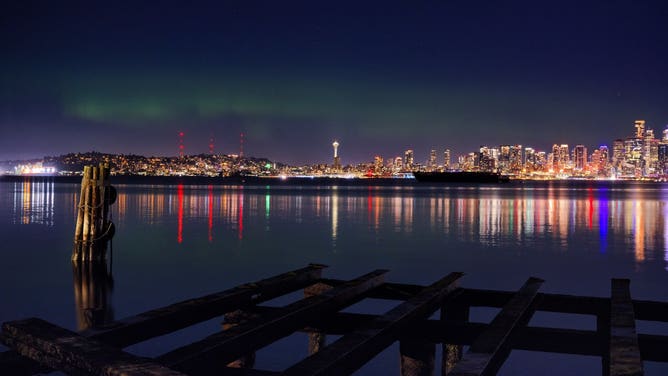
The aurora lights fueled by a geomagnetic storm were bright Monday, Oct. 11, 2021, even over Seattle.
(Tim Durkan)
Local meteorologists say it was one of the most vivid displays of the Northern Lights in the Seattle area since the skies lit up in color on Mother's Day in 2016.
"Aurora displays are fairly rare around the Seattle area," says FOX Weather Digital Meteorologist Scott Sistek, who is based in Seattle. "Maybe they'll be out a couple of times a year and they're usually faint and only visible in long-exposure photos. But this event was so strong, some in the heart of Seattle could still see the Northern Lights dance over the skyline despite the abundant light pollution."
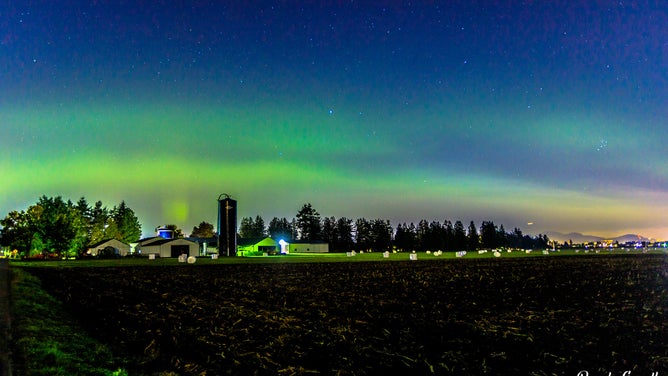
The aurora lights over Lynden, Washington on Monday, Oct. 11, 2021.
(Randy Small)
And those who made the chilly trek to darker locations outside the city lights were treated to green and purple ribbons visible to the naked eye.
Greg Johnson of Skunkbayweather.com recorded the dancing lights over Hansville, Washington.
Timelapse video captures aurora lights over Hansville, WA
Timelapse video captures aurora lights over Hansville, WA.
In Montana, the purple and green lights appeared to dance off the mountain tops.
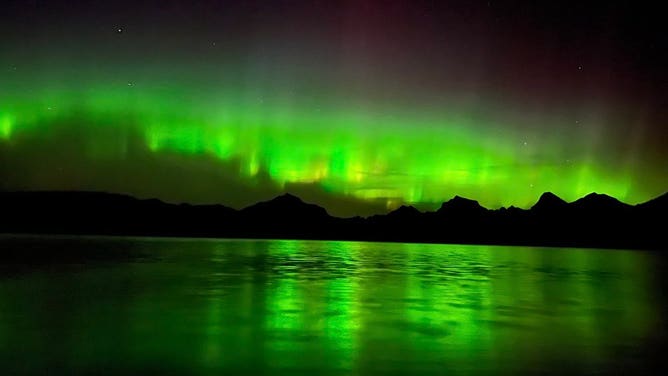
The northern lights dance over the mountains in Montana. (Image credit: Josh Arrants)
(Josh Arrants)
The green lights over Crosslake, Minnesota, gave off an eerie glow reflecting off the lake.

The aurora lights on Monday, Oct. 11, 2021, from Crosslake, Minnesota. Image by Jackson Purfeerst
(Jackson Purfeerst)
Even in black and white, the swirls were evident from NOAA satellites in space.
NOAA's Cooperative Institute for Meteorological Satellite Studies at the University of Wisconsin-Madison shared images of Monday night's peak auroras as seen from low-Earth orbit.

The northern lights as seen from a NOAA satellite on Monday, Oct. 11, 2021.
(NOAA/NASA)
The auroras were also seen from space by the astronauts living and working on the International Space Station. The crews onboard have some of the best views of Earth anywhere.
NASA Astronaut Shane Kimbrough shared this image taken from the ISS just before the sun came up.
I caught this aurora just as orbital sunrise was beginning. Breathtaking! pic.twitter.com/8km6i4M5Vj
— Shane Kimbrough (@astro_kimbrough) October 12, 2021
The meteorologists at the Grand Forks, North Dakota National Weather Service Office enjoyed the perks of the overnight shift, which allowed them to witness the geomagnetic storm in full effect.
At NWS Grand Forks, we had to step outside the office to get a glimpse of the lights. Here is meteorologist Jim Kaiser taking in the sights during last night's #AuroraBorealis.
— NWS Grand Forks (@NWSGrandForks) October 12, 2021
Sometimes the midnight shift can have it's perks ☕️. #ndwx #mnwx #northernlife pic.twitter.com/sVbwVhUux9
The solar storm also meant people in areas where the lights are visible every day saw more intense colors and movements.
The geomagnetic storm was expected to linger into midday Tuesday then subside, leaving the aurora to retreat back toward the polar region. However, the sun activity is expected to increase and become more frequent over the next three to four years as it heads toward the most active part of its 11-year solar cycle, expected to peak around 2024 or 2025.
